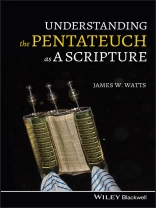A cutting-edge scholarly review of how the Pentateuch functions as a scripture, and how it came to be ritualized in this way.
Understanding the Pentateuch as a Scripture is a unique account of the first five books of the Bible, describing how Jews and Christians ritualize the Pentateuch as a scripture by interpreting it, by performing its text and contents, and by venerating the physical scroll and book.
Pentateuchal studies are known for intense focus on questions of how and when the first five books of the Bible were composed, edited, and canonized as scripture. Rather than such purely historical, literary, or theological approaches, Hebrew Bible scholar James W. Watts organizes this description of the Pentateuch from the perspectives of comparative scriptures and religious studies. He describes how the Pentateuch has been used in the centuries since it began to function as a scripture in the time of Ezra, and the origins of its ritualization before that time. The book:
* Analyzes the semantic contents of the Pentateuch as oral rhetoric that takes the form of stories followed by lists of laws and sanctions
* Gives equal space to its ritualization in the iconic and performative dimensions as to its semantic interpretation
* Fully integrates the cultural history of the Pentateuch and Bible with its influence on Jewish and Christian ritual, and in art, music, theatre, and film
Understanding the Pentateuch as a Scripture is a groundbreaking work that highlights new research data and organizes the material to focus attention on the Pentateuch’s–and Bible’s– function as a scripture.
Daftar Isi
List of Boxes ix
List of Tables xi
List of Figures xii
Abbreviations xv
Preface xvii
Acknowledgements xxii
1 Ritualized Text: The Pentateuch as a Scripture 1
Torah and Pentateuch 2
Scripture and Ritual 3
The Three Dimensions of Written Texts 6
Ritualizing Scriptures in Three Dimensions 8
The Pentateuch in Three Dimensions 10
Scripturalizing Torah in the Time of Ezra 13
Reading the Pentateuch as a Scripture 17
2 Textual Rhetoric: The Persuasive Shaping of the Pentateuch 19
The Pentateuch as Literature 20
The Pentateuch as Rhetoric 23
Logos: The Story?]List?]Sanction Rhetorical Strategy 25
Ethos and Pathos in Pentateuchal Rhetoric 59
3 Scroll, Tablet, and Codex: Ritualizing the Pentateuch’s Iconic Dimension 68
The Iconic Dimension of Scriptures 69
The Pentateuch’s Iconic Dimension After Ezra 70
The Pentateuch’s Iconic Dimension Before Ezra 108
4 Reading, Performance, and Art: Ritualizing the Pentateuch’s Performative Dimension 123
The Performative Dimension of Scriptures 124
The Pentateuch’s Performative Dimension After Ezra 126
The Pentateuch’s Performative Dimension Before Ezra 155
5 Textual Interpretation: Ritualizing the Pentateuch’s Semantic Dimension 175
The Semantic Dimension of Scriptures 176
The Pentateuch’s Semantic Dimension After Ezra 177
The Pentateuch’s Semantic Dimension Before Ezra 224
6 Scriptures: From Torah to Bible 251
Scripturalization and Canonization 251
In the Time of Judah Maccabee 253
Understanding the Tanak as a Scripture 255
In the Time of Judah Ha?]Nasi 260
In the Time of Irenaeus 262
Understanding the Bible as a Scripture 265
Cited Works and Further Reading 268
Index of Quotations and Citations of Biblical and Rabbinic Texts 286
Index of Subjects and Authors 291
Tentang Penulis
JAMES W. WATTS is Professor of Hebrew Bible in the Department of Religion at Syracuse University. His research involves the overlaps between rhetoric, ritual and scriptures, with a particular focus on the Pentateuch.












